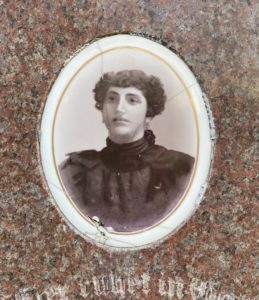1 September 1874 – 13 August 1896
Because of when she was born and died, finding information on Emma is difficult, but we can find a bit more about her parents with whom she shares the headstone.
Christian (1 May 1843 – 18 August 1914) and Wilhelmine “Mina” Reppin Schultz (5 February 1840 – 29 August 1921) were born in Germany, married, and had at least one child there. In 1869, they and their daughter Bertha immigrated to the US and settled in Chicago.
In 1870, a baby Hermann was listed, not yet a year old, but he does not survive childhood, and in 1880, Bertha (15) was the oldest child by ten years, her next-in-age sibling being Emma was only 5 years old. They had one more sibling, Louis, aged 3, and Mina’s widowed mother was living with them.
Once again, the loss of the 1890 census really hurts us here, especially as Emma doesn’t survive to be glimpsed on the 1900 census. We know Emma did not marry, and we know that in 1900, Mina had only two surviving children of eight born (poor Mina and Christian). I believe one of the surviving two was Bertha as no children are living at home with Christian and Mina in 1900.
The other was Louis who in 1899 married Bertha Kobelt (confusing). He and Bertha lived close to his parents for the rest of their lives, all of them settled for many years on West 21st Place in the Lower West Side neighborhood (the location of their building is now an empty lot).
Sadly, Louis died only a year after his mother at the age of 45. He was working as a teamster so illness, accident, or mayhem are all possible causes. His wife Bertha did not remarry, and she and their four children lived on at West 21st Place until the children grew up and moved out. Bertha died in 1946 and all her children survived her.
I cannot track his sister Bertha as there are too many similar marriage records for Bertha Schultzes in Chicago between 1885 and 1900.
 The family plot includes three worn down and unreadable little log headstones beside this monument which may belong to some of the other children, but Emma’s pride of place and the addition of her image to the headstone tells us her loss was particularly felt by this family, perhaps because she and Louis and Bertha had survived their precarious childhood years only for her to be lost just as she was beginning her own adult life.
The family plot includes three worn down and unreadable little log headstones beside this monument which may belong to some of the other children, but Emma’s pride of place and the addition of her image to the headstone tells us her loss was particularly felt by this family, perhaps because she and Louis and Bertha had survived their precarious childhood years only for her to be lost just as she was beginning her own adult life.
It’s hard to be sure as the image is fairly worn, but it almost looks more like a drawing than a photo but that could be due to early photography technology or the way it was converted to the cameo for the headstone.
RIP Emma and family
Please visit my Instagram for any questions or comments on this post!
